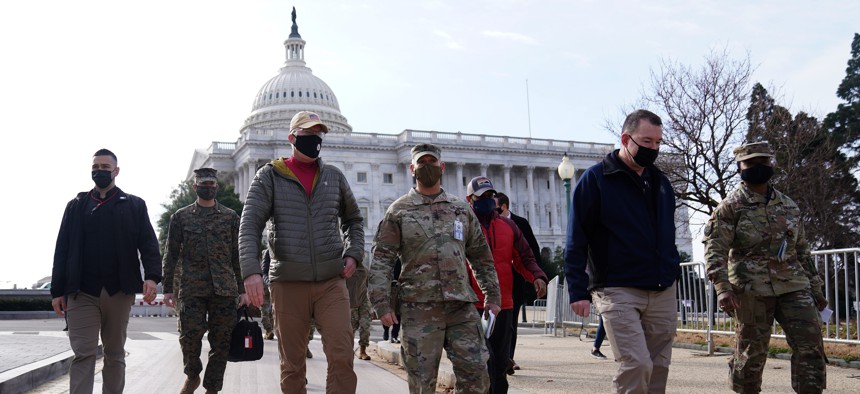
Acting Secretary of Defense Christopher Miller (third from left) walks with members of the National Guard outside the U.S. Capitol on January 17, 2021, in Washington, DC. Getty Images / Eric Thayer
‘Hype’ Over Military Coup Fears Delayed Troops’ Jan. 6 Response, Miller To Tell Congress
In testimony, former Acting SecDef Christopher Miller will say he dismissed Trump’s warning that 10,000 troops should be ready for his rally in Washington, but blames the media and credits his own deliberations for slowing the military's response at the Capitol.
Former Acting Defense Secretary Christopher Miller was aware protestors had entered the U.S. Capitol on Jan. 6 for roughly one hour before he met with top military leaders to coordinate a response, he will tell Congress on Wednesday.
Miller’s testimony, a copy of which was obtained in advance by Defense One, is the first from President Donald Trump’s former top defense official on the government’s response to the riots.
In it, Miller confirms that Trump warned him one day prior to the planned political rally that preceded the attack on the Capitol, that he would need to have 10,000 troops at the ready, which the acting defense secretary did not take as a serious comment or instruction.
Miller is scheduled to appear before the House Committee on Oversight and Reform on the military’s response to the Capitol attack on Wednesday. What Miller is expected to say is likely to do little to sway some lawmakers who claim that the Pentagon’s response to the breach and rioting by pro-Trump protestors was slow-rolled by his acting defense secretary.
“More than four months later, Congress and the American people still have many unanswered questions about why the Trump administration did not do more in response to open threats of violence espoused by violent right-wing extremists before the attack, and why federal agencies were so slow to respond once the attack began,” said committee chairwoman Rep. Carolyn Maloney, D-N.Y..
In his testimony, Miller said he became aware of the breach between 1:00 p.m. and 1:30 p.m. and met with Joint Chiefs Chairman Gen. Mark Milley and Secretary of the Army Ryan McCarthy around 2:30 p.m.
National Guard members did not arrive on scene until 5:22 p.m., a time lag which Miller said in his testimony has been unfairly criticized.
“This isn’t a video game where you can move forces with the flick of a thumb,” Miller said in his written remarks. “We appreciated the seriousness of the situation, but we did not want to piece-meal National Guard forces into the zone of conflict.”
Former chief of the D.C. National Guard,Gen. William Walker, who is now the Capitol’s sergeant-at-arms has previously said they had a direct call for help from then-U.S. Capitol Police chief Steven Sund at 1:49 p.m., and had National Guard members ready on busses at the D.C. Armory to respond.
Miller also confirms that on Jan. 5, one day prior to the attack, President Donald Trump mentioned briefly to him that “‘they’ were going to need 10,000 troops the following day.” At the time, the Defense Department had authorized 340 troops to conduct mainly traffic control.
“The call lasted fewer than thirty seconds and I did not respond substantively, and there was no elaboration,” Miller said, in his prepared testimony. “I took his comment to mean that a large force would be required to maintain order the following day.”
Miller said he was hesitant to send troops to the Capitol because of the potential they would be perceived as arriving in support of the election challenge, or worse.
Miller also blamed the media, saying that he did not want to put military forces in that role after speculative “commentary in the media about the possibility of a military coup or that advisors to the President were advocating the declaration of martial law.”
“No such thing was going to occur on my watch,” Miller said. “But these concerns, and hysteria about them, nonetheless factored into my decisions regarding the appropriate and limited use of our Armed Forces to support civilian law enforcement during the Electoral College certification. My obligation to the Nation was to prevent a constitutional crisis.”
Five people died as a result of the Capitol attack, including a U.S. Capitol police officer.
The violence on Jan. 6 led to a much more substantial U.S. military response leading up to President Joe Biden’s inauguration, two weeks later. More than 26,000 National Guard forces were deployed to the city and protective perimeter fencing and military barriers remained in place for months after the event. Congress is still debating what long-term additional security measures may be needed for the Capitol complex.




